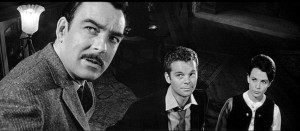
The Hendersonville Film Society goes Halloween with Robert Wise’s The Haunting (1963). I confess that this is not a film I’ve ever warmed to—primarily because I find Julie Harris’ character so completely unappealing that I don’t give a damn what happens to her. (In fact, I’d like to slap her on several occasions.) That said, this is one super-creepy haunted house story—and quite possibly the most stylish picture Robert Wise ever made. It’s easy—in light of films like The Sound of Music (1965)—to forget that Wise started his career as an editor, and worked with (and some might say against) Orson Welles, cutting both Citizen Kane (1941) and, more unfortunately, The Magnificient Ambersons (1942). While there’s a certain gothic, Wellesian quality to some of Wise’s work, The Haunting is so completely Wellesian that it’s tempting to think of it as Citizen Ghost. (The handling of the opening narration that sets up the story of the evil house is like the opening of Ambersons—in horror movie form.) As filmmaking, The Haunting is close to flawless, and Wise uses everything at his disposal to keep the atmosphere going for the entire length of the film (as long as the staging is in the house). The story is actually fairly straightforward, with its scientist and his two “subjects” trying to get to the heart of whether or not the house is haunted (we’re not left with any doubt), but it’s the way in which Wise—aided by composer Humphrey Searle and cinematographer Davis Boulton—presents the film that makes it so compelling and, yes, convincing.
One of the most striking things about The Haunting is Wise’s use of deep focus—something that Welles had taken to new heights in Citizen Kane. And since nothing else in director of photography Davis Boulton’s carrer suggests anything even remotely like this, it’s only reasonable to assume that Wise was the responsible party. Of course, by 1963 Wise had access to lenses Welles never dreamed of—especially in terms of wide-angle lenses, which, by their very nature, have much greater depth of field (the area in focus). But wide-angle lenses come with an inherent distortion problem, especially at the edge of the frame—and the only time there’s this distortion in The Haunting it’s obviously deliberate. The only way he got some of these shots—like the amazing one below—was by pouring on the light and stopping way the hell down (the smaller the lens opening, the greater the depth of field, but the more light required).

Another surprising thing about the film is that—without stating it (that was not flying in 1963)—Claire Bloom’s character is obviously a lesbian and more than a little attracted to the Julie Harris character. In fact, her interest is almost predatory—as if she’s simply fascinated by her companion’s totally virginal naivete. It’s true that William Wyler had made The Children’s Hour in 1961 and dealt surprisingly frankly—without ever using the word, of course—with lesbianism, but that had a literary pedigree in the Lillian Hellman play and significantly the presumed lesbian came to a bad end. (Wyler had made a much changed version of the play in 1936 for Sam Goldwyn, who’d bought the play without understanding the topic. In fact, when apprised that the play couldn’t be filmed because it was about lesbians, he was famously supposed to have said, “We can always call them Bulgarians.”) It’s much more surprising to find the topic in The Haunting, especially since the Bloom character doesn’t come to a bad end and the whole thing is treated in a casual matter-of-fact manner.

All in all, it’s certainly an effective and beautifully made film—one of a very small handful of good movies about actual haunted houses—but, as I said, I remain feeling a little remote from it all because of the Harris character. But for sheer spooky atmosphere, you’re not going to find much better.




Wise told me in an interview back in 1980 that he made THE HAUNTING as a tribute to producer Val Lewton who gave Wise his start as a director. He said “I wanted to make a Val Lewton picture with all of his trademarks but on an “A” budget”.
Still looks more like Welles than Lewton.
This movie scared the bejeezus out of me when I first say it back in the 1960s, and remains one of the best of its type.